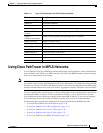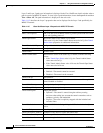
11-33
Cisco Prime Network 4.0 User Guide
OL-29343-01
Chapter 11 Using Cisco PathTracer to Diagnose Problems
Using Cisco PathTracer in MPLS Networks
Table 11-14 describes the Layer 2 properties that can be displayed in the Layer 2 tab specifically for
VPNs.
Using Cisco PathTracer for MPLS TE Tunnels
Cisco PathTracer uses label switching information to trace the end-to-end path of a TE tunnel path from
one PE router to another.
Using MPLS TE technology, Cisco PathTracer enables you to:
• View a path or list of devices.
• View the following information for each network element:
–
The relevant parameters for each interface on all layers along the path.
–
The path for the defined MPLS TE-LSP across the network.
The Cisco PathTracer window is displayed showing the MPLS TE tunnel topology map. From this
window, you can open the Cisco PathTracer details window with the appropriate MPLS TE tunnel
information displayed in the Layer 2 tab.
Note Cisco PathTracer does not display or trace EXP bits for Layer 3 VPNs that use PBTS.
Table 11-14 Cisco PathTracer Layer 2 Properties for VPNs
Field Description
Top Label Details of the outer MPLS label.
Label Stack Details of the inner MPLS label.
MAC Address MAC address.
Tunnel ID Tunnel identifier. The identifier and the router IP address of the two
tunnel edges identify the pseudowire tunnel.
Tunnel Type Tunnel type:
• 0—Unknown
• 1—PWE3
• 2—TE
Tunnel Status Operational state of the tunnel: Up or Down.
Tunnel Local VC Label MPLS label that is used by the router to identify or access the tunnel. It
is inserted in the MPLS label stack by the local router.
Tunnel Peer VC Label MPLS label that is used by the router to identify or access the tunnel. It
is inserted in the MPLS label stack by the peer router.
Tunnel Local Router IP IP address of the tunnel edge, which is used as the MPLS router
identifier.
Tunnel Peer Router IP IP address of the peer tunnel edge, which is used as the MPLS router
identifier.
Distribution Protocol
Type
Protocol used by MPLS to build the tunnel, such as LDP or TDP.
Peer OID Tunnel identifier and device name.


















